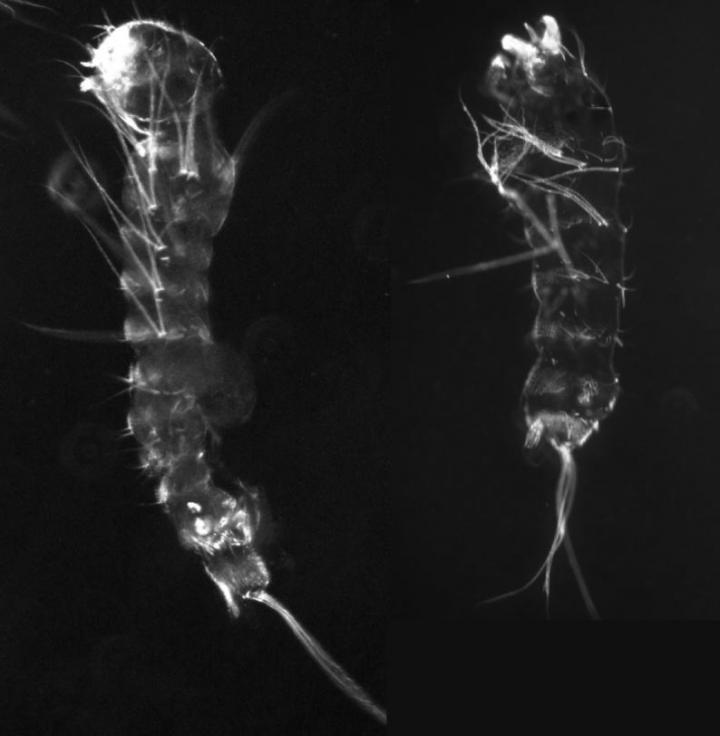UMD study suggests caution is needed for research that presumes closely related species use the same genes for similar functions

Credit: Image credit: Alys Jarvela/University of Maryland.
University of Maryland entomologists discovered that a gene critical for survival in other insects is missing in mosquitos–the gene responsible for properly arranging the insects’ segmented bodies. The researchers also found that a related gene evolved to take over the missing gene’s job. Although laboratory studies have shown that similar genes can be engineered to substitute for one another, this is the first time that scientists identified a gene that naturally evolved to perform the same critical function as a related gene long after the two genes diverged down different evolutionary paths.
The work emphasizes the importance of caution in genetic studies that use model animals to make conclusions across different species. It also points to a new potential avenue for research into highly targeted mosquito control strategies. The research study was published in the September 30, 2020, issue of the journal Communications Biology.
“Every single arthropod has a segmented body plan. And you would think it develops the same way in all of them. But what we found is that it doesn’t,” said Alys Jarvela, a postdoctoral associate in the UMD Department of Entomology and the lead author of the study. “We learn a lot in biology by studying a process in a model organism and assuming that it works essentially the same way, using the same genes, in other organisms. That is still an incredibly useful approach. But, now we know that there is also a possibility for gene substitutions to be made in nature.”
Jarvela discovered the missing gene in mosquitos by accident. She was studying crickets and attempting to cross-check her genetic samples by comparing the gene sequences of crickets with those of other insects. She was specifically interested in a gene called paired, one of a handful of genes that guides the pattern of repeated parts in segmented animals like insects. Laboratory studies had shown that when paired is knocked out or silenced in fruit flies, every other segment of the insect’s body fails to develop, and it doesn’t survive.
“I was just trying to find the mosquito version of paired to use as a reference point, and I couldn’t find, it,” Jarvela said.
When she searched for paired in all publicly available databases of mosquito genomes, she discovered it was missing from every mosquito species represented.
“Once we accepted that the gene was really absent, we thought that was a pretty wild mystery and immediately changed gears to satisfy our curiosity,” Jarvela said.
Jarvela’s team searched the genomes of fly species closely related to mosquitos and found they all contained the paired gene. This indicated that the loss of paired is a recent evolutionary event that took place only in mosquitos. It was clear to the researchers that some other gene in mosquitos must be performing the same function as paired does in other insects.
They found clues suggesting which gene could be involved in a 1996 experiment on fruit flies. In that study, scientists knocked out paired and replaced it with a closely related gene called gooseberry, which normally has a distinct role at a later time in development. That was a highly engineered experiment, but it showed that when gooseberry was manipulated to express at the right time during development, fruit flies without the paired gene developed normal alternating segments and survived.
To find out if gooseberry had naturally evolved as a substitute for paired in mosquitos, Jarvela and her team used CRISPR to edit gooseberry out of a mosquito species called Anopheles stephensi. The mutated mosquito embryos looked like laboratory fruit fly embryos that had paired knocked out.
“This work shows that even when different species share a trait or feature, the genetic mechanisms underlying this shared trait may be different,” said Leslie Pick, professor and chair of the Department of Entomology at UMD and the study’s senior author. “In the case reported in this paper, segmentation still happens even though a gene we thought was essential is lost. Our next steps will be to search for additional examples of variation in gene regulatory networks in insects and try to determine how genetic rewiring occurs in nature.”
Jarvela is also interested in probing other aspects of mosquito development that may be affected by the loss of the paired gene. In addition to controlling segmentation, which is critical for survival, paired influences male fertility in fruit flies.
“That means different genes probably regulate male fertility in mosquitos, and they might be unique to the mosquito, which could potentially provide a powerful avenue for controlling mosquitoes without harming other insects such as butterflies and bees,” Jarvela said.
###
The research paper, “Regulatory gene function handoff allows essential gene loss in mosquitoes,” Alys M. Cheatle Jarvela, Catherine S. Trelstad, Leslie Pick, was published on September 30, 2020, in the journal Communications Biology.
This work was supported by the National Institutes of Health (Award No. R01GM113230). The content of this article does not necessarily reflect the views of this organization.
About the College of Computer, Mathematical, and Natural Sciences
The College of Computer, Mathematical, and Natural Sciences at the University of Maryland educates more than 9,000 future scientific leaders in its undergraduate and graduate programs each year. The college’s 10 departments and more than a dozen interdisciplinary research centers foster scientific discovery with annual sponsored research funding exceeding $200 million.
Media Contact
Kimbra Cutlip
[email protected]
Original Source
https:/
Related Journal Article
http://dx.




